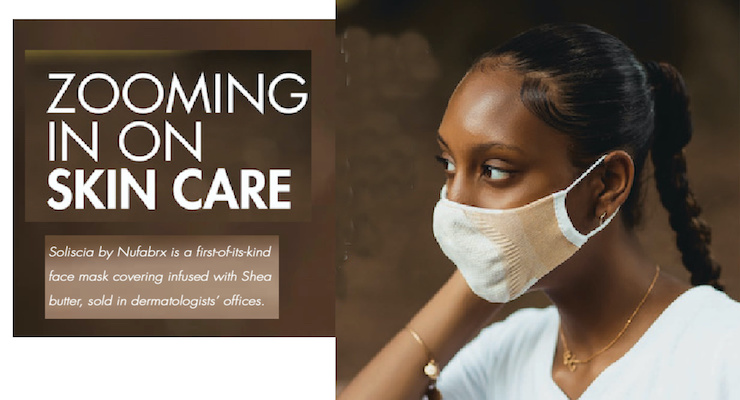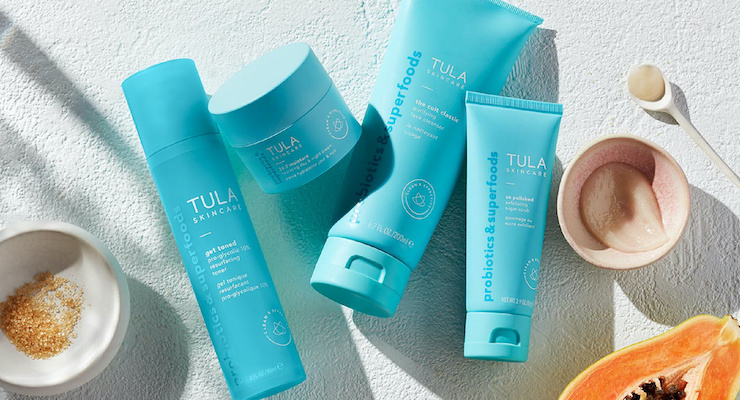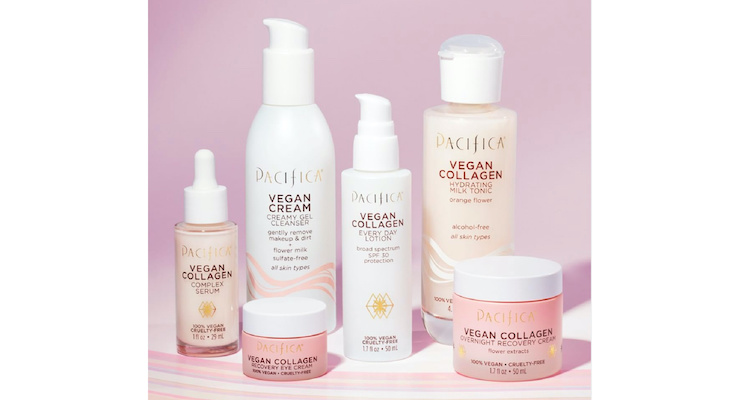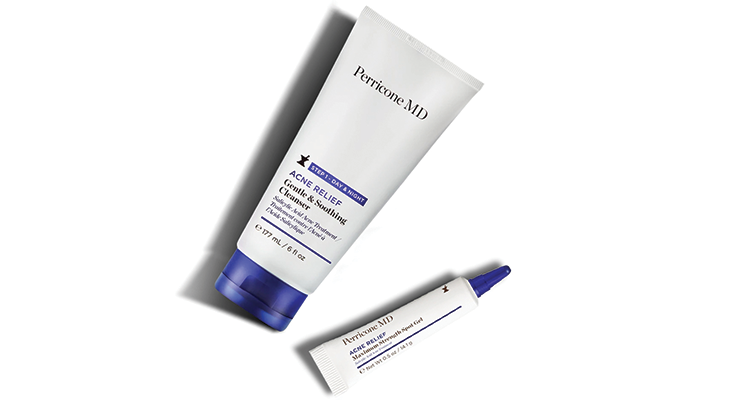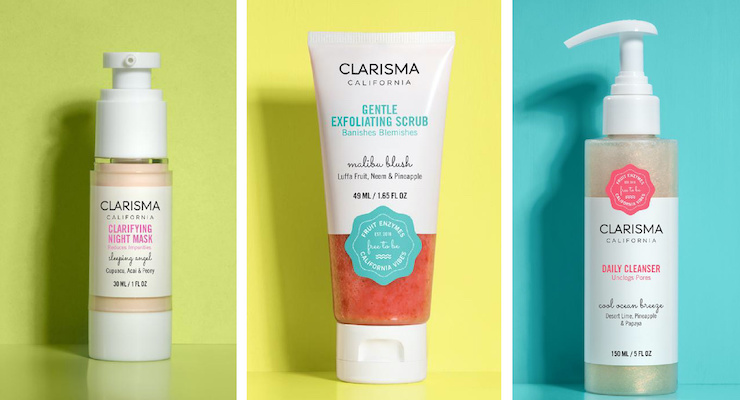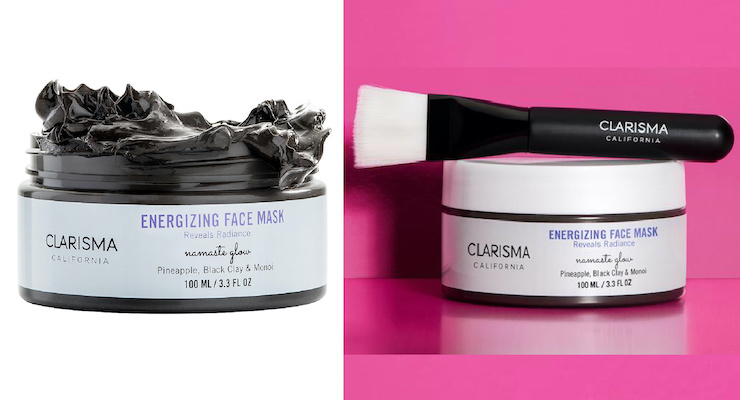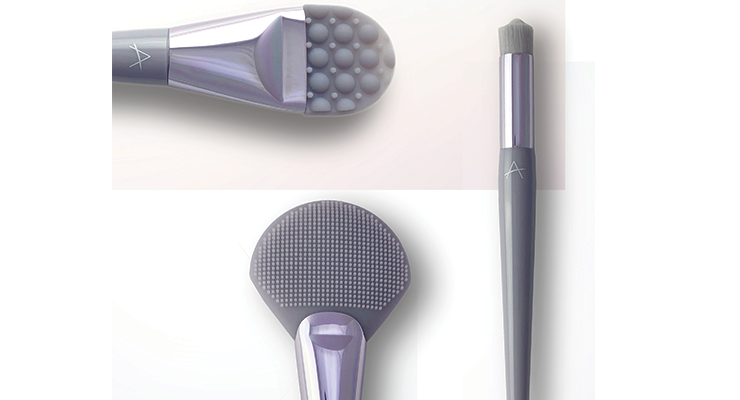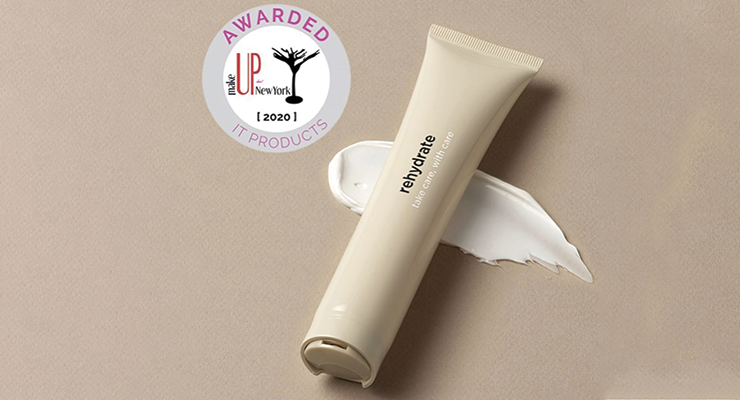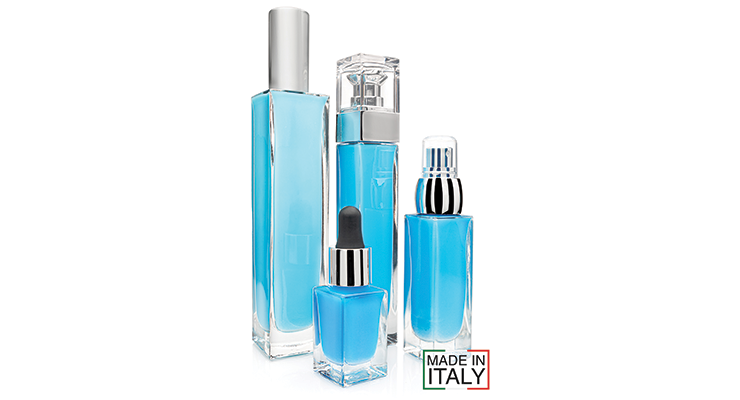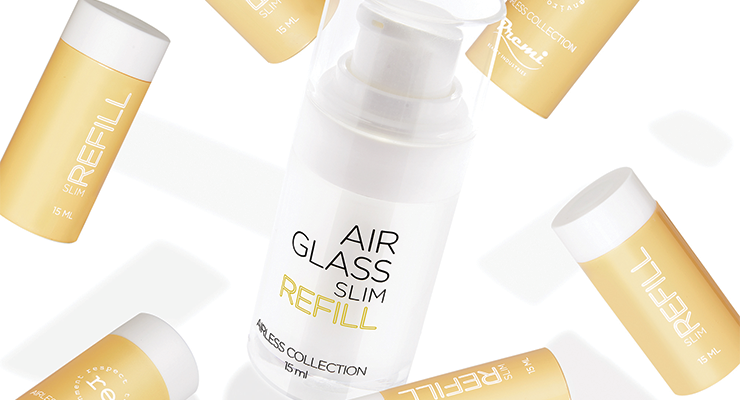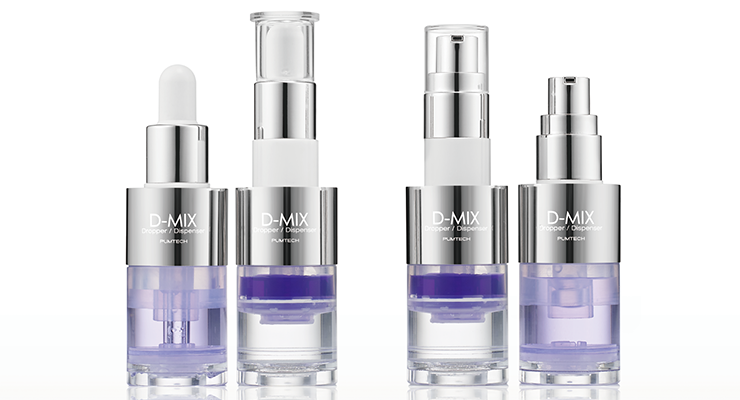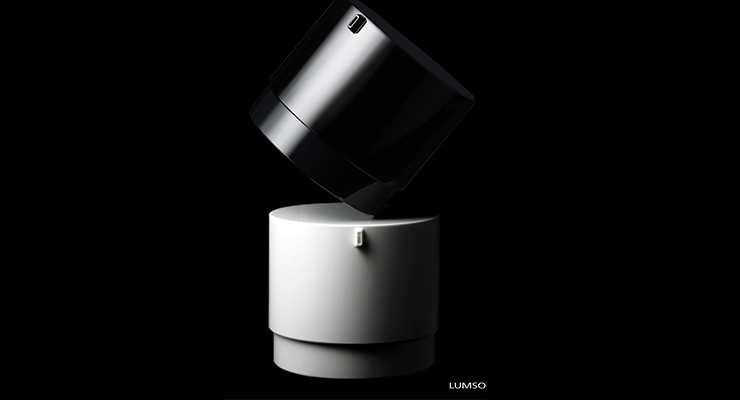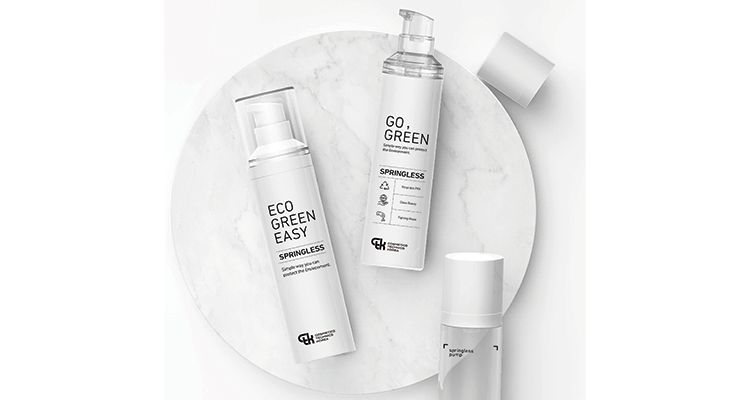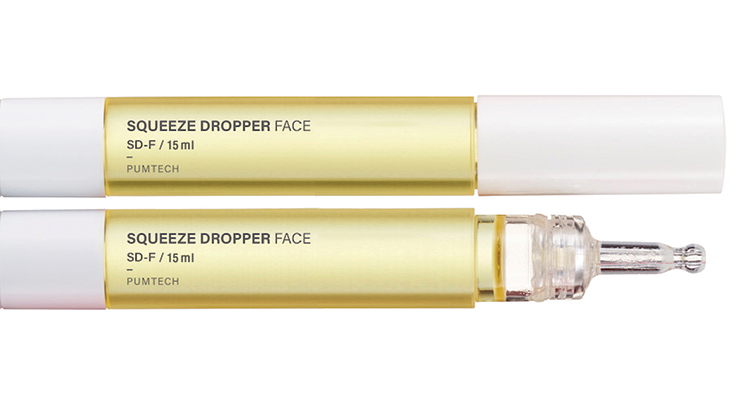Marie Redding, Senior Editor11.04.20
It’s been a challenging year, since every aspect of the beauty industry has been affected by the Covid pandemic. When Zoom calls replaced in-person meetings and face coverings hid our lips, the market changed instantly. Beauty fans no longer needed a new lipstick color, nor did they have a way to sample one in-store—but stress-relieving skin care rituals became an essential stay-at-home activity.
“Consumers are using more products and starting new beauty routines. This trend has accelerated in recent months—and we expect the demand for skin care to continue to rise, compared with color cosmetics, due to the current situation,” says Crystal Xie, skin care product manager, HCP Group.
Photo above: Soliscia Shea Butter Infused Mask by Nufabrx, description below
The ‘Skin Care Effect’ Replaces the Lipstick Index?
Some experts are calling face creams and sheet masks “the new makeup.” The cosmetic skin care market expects to register a CAGR of almost 5% from 2020 through 2024, according to Technavio’s report. Forecasters say the increase is due to the current rising demand for face cleansers and sheet masks.
Many beauty brands quickly recognized how market demands were changing at the start of the pandemic and adapted to the “new normal” by ramping up e-commerce efforts. TULA Skincare, a ‘clean’ brand formulated with probiotics and superfoods, saw sales rise, with an “average order value” increasing by 25%.
Savannah Sachs, CEO, TULA, explains, “While previous economic recessions have yielded ‘the lipstick effect,’ the latest pandemic has shown us what we like to call the ‘skin care effect,’ in which more consumers are shifting their focus from color cosmetics to self-care and skin care regimens.”
Consumers are relying on skin care as a way to “control some aspect of their wellness,” Sachs says. “Our recent growth shows that our customers are investing in full product lines, to use as a skin care routine, rather than just replenishing a single product,” she says.
The global probiotic cosmetics market was forecasted to “plummet” during the first two quarters of this year, according to Fact.MR, due to the Covid pandemic creating disruptions in the supply chain. The market demand, however, is expected to rise by the end of this year, becoming “highly lucrative,” the report says—growing at a CAGR of nearly 11% through 2030.
WWP Beauty is one supplier addressing these trends, and recently launched its ‘Intentional Beauty’ collection “to help consumers navigate stress, anxiety, and a changing beauty landscape,” the company states. The collection includes Rehydrate Moisturizer, Glow Effect liquid highlighter (described below), and a hand sanitizer. “We combined impactful formulas with sustainable and innovative packaging,” says Shandon McGee, innovation committee co-chair, WWP Beauty.
Self-Care Fuels Demand for Packaging
Some suppliers say the rising interest in skin care—and self-care—is also fueling demand for bath and body products. “We see more orders coming in for bottles with dispensing caps, for products such as body wash,” says Vinay Upasani, president, Global Packaging.
Eleanor Bunting, marketing manager, ICS, notes the same trend for body products. “The skin care boom isn’t stopping at the face,” she says. “We see a dramatic rise in demand in recent months, especially for bottles, sprayers, pumps, jars, droppers, and tubes.” Bunting also mentions a notable rise in requests for sustainable packaging, such as recyclable plastic, as well as an increased interest in glass.
Jackie Paterno, vice president, CTK Cosmetics, also sees a growing need for sustainable packaging. “The skin care category is definitely on the rise. Brands are developing and launching many new types of formulas, including serums, creams, and mists—and they are requesting innovative packaging that is sustainable.”
CPP Global is also fulfilling an increasing number of orders. “Demand for our skin care packaging is continuing on its path to double-digit growth this year,” says Brian Tauber, the company’s chief executive officer. “While brands don’t seem to be introducing as many new products or holiday promotions, current product demand continues unabated.”
Tauber says brands are increasing gift-with-purchase promos—perhaps in an effort to entice loyal shoppers to spend more. “We see an increase in smaller jar orders, due to this,” says Tauber. “Similarly, e-commerce is an obvious channel that is exploding, so plastic jars meet many of the packaging requirements to comply with current shipping standards.”
HCP’s Xie says, “The self-care trend means more consumers are looking for high-performance products—and ones that will boost their mood. We have many innovations to offer our customers due to our partnership with PTK (Pum-Tech Korea).”
Rosa Porras Mansilla, marketing and communications manager, Virospack, says consumers are more interested in “skin care cosmetics,” rather than traditional makeup—products that blur category lines. “Consumers have changed their spending habits, and the ‘no-makeup’ look has become a top trend,” she says.
Romualdo Priore, marketing director, Lumson, agrees, calling the trend ‘make-care.’ “I wouldn’t say there is less of a demand for makeup, but rather a re-interpretation of makeup in terms of make-care. New skin care brands are driving significant changes in their methods of approaching consumers, affecting also makeup.”
Skin Care for Issues Caused By Mask-Wearing
Wearing masks apparently causes “maskne,” a new pandemic-related skin issue—but marketers are already providing beauty consumers with solutions. Dr. Barbara Sturm launched the Maskne Set, “to help prevent and treat acne caused by face coverings.” It includes a Nano-Silver Mask, Anti-Pollution Drops, Calming Serum, Clarifying Spot Treatment and Clarifying Mask.
Oh So is a new all-natural self-care line. Oh So’s Face Mist, shown, comes in mood-boosting scents—Rose Water or Geranium Vanilla. It claims to keep your skin clean, clear, and hydrated.
The brand’s hero ingredient is colloidal silver, used for its antimicrobial properties to prevent maskne breakouts. Oh So also makes a Safety Set, which includes its Sweet Orange Hand Sanitizer and Mint Eucalyptus Mask Refresher, to spritz on your face covering. The products are all in 2-fl.-oz plastic bottles with pump sprays.
Soliscia by Nufabrx is a first-of-its-kind reusable Shea-butter-infused mask, designed for use as a face covering—and it provides skin care benefits. Active ingredients, including copper, which deters bacteria growth, are embedded in its fibers. The mask is washable, up to 25 times. It is sold through dermatologists’ offices, and online.
Unlike traditional microencapsulation processes, or coating a material, “our difference is the ability to stabilize ingredients within a material over a long period of time,” explains Glenn Normoyle, chief revenue officer, Nufabrx.
The company can use this technology to infuse any type of material with skin care ingredients, which will be released in a controlled amount, when in contact with the skin.
Maskne is fueling increasing demand for all types of skin care products, especially anti-acne ranges. Perricone MD partnered with ICS to launch its Acne Relief Prebiotic Acne Therapy product line, in tubes. “The brand requested a cost-effective option, so we developed the ideal tube, applicator and cap configurations for their Gentle & Soothing Cleanser and Acne Relief Maximum Strength Spot Gel formulas,” says Eleanor Bunting, marketing manager, ICS.
“Perricone MD Acne Relief successfully launched earlier this year—and has also proven to be an effective solution to address the recent maskne phenomenon,” says Bunting. ICS tubes are also available in sustainable PCR and sugarcane bio-resins.
The Cleanser is in a co-extruded tube with an EVOH layer, featuring an oversized orifice to accommodate the unusually thick formula. “It has a convenient flip-top cap that makes it easy to use in the shower, Bunting says. The Spot Gel is also a co-extruded tube with an EVOH layer, but with a needle-nose applicator. “It allows for a precise, targeted spot application of the very fluid formula,” says Bunting.
SeaCliff Beauty worked with Rodan & Fields, providing tubes and jars for its acne line. The brand’s Intensive Renewing Serum is packaged in capsules, in a clear jar, shown. “I also see more requests for soothing skin care, such as cooling eye masks, face spritzers, and hyaluronic skin creams,” says Vonda Simon, founder and president, SeaCliff Beauty.
Tubes Offer Convenience
John Ulibarri, senior account executive, JSN Packaging, says many brands prefer tubes for acne products—and hand sanitizer. “Tubes dispense a product easily, and the potential for cross-contamination is less,” he says.
JSN offers brands sustainable sugar cane tubes, plus tubes and caps made using post-consumer recycled materials (PCR). “We are seeing an increasing demand for tubes from nearly all our major skin care customers,” says Ulibarri. “Many brands we work with are actively developing and launching new skin care products now,” he adds. JSN has also been working with brands to supply tubes for hand sanitizer, including DermOrganics. The company launched ‘Kill It!’ Sanitizer Gel, shown, for hair stylists and aestheticians.
Global Packaging’s Upasani, agrees, and says their tubes are requested often. “We offer tubes with different spot applicators, including needle noses, dropper heads, silicone heads, brush heads and more,” he adds.
WWP Beauty’s Eco-Pac tube, which is included in its new collection, mentioned above, recently won top honors in the Sustainable Development category during the 2020 MakeUp in New York Innovation Awards. It is made from 100% bio-PE and features a lightweight design that utilizes up to 19% less plastic, and produces 93% fewer emissions per piece.
TULA, mentioned above, launched a sunscreen/skin care hybrid product in April, in a yellow tube. Tula’s Protect + Glow Daily Sunscreen Gel became the brand’s most requested product in recent months. It contains “skin care-first ingredients,” the brand says, to promote even skin tone and strengthen the skin barrier. It’s also a broad-spectrum SPF 30 chemical sunscreen, and it gives the skin a lit-from-within glow.
‘Clean’ Beauty, Glass & Refillables
There is an increasing interest in “natural,” “clean” and vegan beauty, as more consumers question ingredients—but especially now, since anything wellness-related seems more appealing during a health crisis. Data from Moz shows that searches for “clean skin care” rose to 6.5k searches each month since March.
Recognizing this growing demand Pacifica launched its Vegan Collagen Skincare Collection, in glass packaging (shown above, photo via Instagram/pacificabeauty). The Hydrating Milk Tonic is in a slender, glass bottle with a thick base.
The clear glass showcases the milky pink product. “This bottle felt super luxe, to us, and communicated our brand values,” says Brook Harvey-Taylor, president & founder, Pacifica Beauty. “It can be recycled curbside. We also love the look of the glass, it’s gorgeous and chic,” she adds.
Sustainability is a key pillar for Pacifica, Harvey-Taylor says, since the brand was founded 25 years ago. “We continually strive to do better for our planet—from the ingredients, we source to the packaging it comes in. By migrating to PCR and glass, we have been able to remove thousands of pounds of virgin plastic from entering the waste stream in 2020,” she says.
Many Indie skin care brands are choosing glass packaging, according to Dave Desai, vice president of sales and marketing, New High Glass. “We have seen a tremendous surge toward glass for skin care packaging,” says Desai. This is driven by Indie skin care brands’ commitment to sustainability, as well as the emergence of certifications such as COSMOS (COSMetic Organic and natural Standard) by Eco-Cert.
New High Glass’ Klee collection is shown (left). “If a small brand wanted glass packaging, they typically gravitated toward Boston Rounds, due to their ubiquitous availability,” says Desai. “We wanted to change this, so we launched six different collections of glass containers with closures available from stock, in the U.S. Further brand differentiation is achieved through a myriad of decoration techniques that can also be functional, such as providing UV protection for light-sensitive formulations.”
Premi Beauty Industries offers its Pure Packaging Collection, a line of 100% recyclable glass packaging. The line includes, bottles and jars in several sizes. “We balance a high-quality design with the ability to use thinner glass, to reduce the necessary materials,” says Federico Prestini, managing director, Premi Beauty Industries.
Premi’s Airglass collection—and the Airglass Slim Refill—is glass, airless and refillable. “It is perfect for skin care and makeup, and comes in three sizes,” says Prestini. The components are easily separated for recycling.
Premi is also developing an airless glass refillable jar. “It’s a win-win for brands so that they can offer a sustainable package, and consumers will know they are taking care of the planet,” adds Prestini.
Airless Packaging Prevents Contamination
Airless packaging is always in demand for skin care products, due to its ability to protect a formulation with less chemical-based preservatives. Airless dispensing systems provide ease-of-use—and typically, a luxe look.
According to a recent report by Research & Markets, the global airless packaging market size is expected to reach $8.1 billion by 2027, expanding at a CAGR of 6.0% over the forecast period.
“Airless is still our most requested type of package for skin care,” says SeaCliff’s Simon. We offer both airless jars and bottles in all types of plastic, including PCR, and glass refillable airless packaging, too. Products packaged in these types of components include serums, facial mists (with airless sprayers) night and day creams, and neck creams.
Premi’s Prestini says, “Skin care brands are always looking for airless packaging because consumers know the packaging helps to preserve the beauty formula in a safe way. It also helps a brand to match a product’s functionality and safety, and convey a high perceived value.”
CPP Global’s Tauber says requests for anti-microbial packaging are on the rise. “We are currently designing a proprietary airless jar that combines antimicrobial security, ease of customer use, and greater affordability. We expect to have prototypes available soon,” he says.
HCP’s Xie says hygiene is at the forefront of everyone’s minds—both consumers and brands. “Dispensing via a pump, without coming into contact with a product, is highly preferable now,” she says.
HCP, through its partnership with PTK, offers airless packaging for single- and double-walled bottles in jumbo and mini sizes—as well as pumps, jars, compacts, and tubes. “We have many airless options that provide a controlled dose, and give products an extended shelf life because exposure to air is reduced,” says Xie. In addition, the company’s dual-chamber designs, shown, have the ability to fresh-mix two active treatment products.
ICS’ Bunting also says consumers may re-think sticking their finger into a jar due to the pandemic. “We are all more scrutinous regarding hygiene, so our packaging preferences will change,” she predicts.
Bunting says airless packages that offer a “hands-free” application are in demand, to keep formulas contaminant-free. ICS offers these options, plus has an extensive selection of airless pump and sprayer bottles and airless jars. They are ideal for a variety of skin care products, including lotions, cleaners, mists and other treatments.
Lumson offers airless solutions that are also touchless. “Consumers favor packaging that can provide product purity, and our airless and touchless solutions provide this guarantee,” says Priore.
“Our airless systems—jars and bottles—are renamed as ‘Touchless’ to highlight our safety features,” he explains.
Lumson’s Touchless range uses a patented hermetic closure system, positioned between the dispensing system and the bottle in order to protect the formula. A brand can choose a mono- or multi-layer pouch, depending on the characteristics of the product. It can be made in sustainable materials, including glass, plastic, and aluminum. It is also designed to easily separate for recycling.
CTK Cosmetics offers an airless line of springless pumps, which makes them metal-free and completely recyclable—called the Springless Eco Pump. “Airless is always best for skin care,” says Paterno. ”We developed a patented airless pump without a metal SUS spring, and with 100% recyclable materials, so the consumer doesn’t need to disassemble the pump from the bottle before putting it in the recycle bin,” she explains.
Paterno says the company received so much positive feedback about its first springless pump, that the supplier launched additional designs. “Now, we have the world’s first eco-cream pump—no viscosity is too high for this dispensing system,” she says. “It will even work for balms and toothpaste,” she adds.
Another variation is CTK’s Dip Tube Pump. “We just finalized this design, and we will launch a mist pump and a large body care pump,” says Paterno. The eco-friendly springless collection can accommodate products up to 100ml.
Applicator Tools Make Skin Care Jars More Hygienic
Applicator brushes and tools have crossed over from makeup to skin care. Clarisma, a “clean” vegan skin care brand, which just launched exclusively at Ulta, chose a large jar for its Energizing Face Mask. It is meant to apply with a brush, for a more even application that is less messy than dipping into the jar with your fingers.
“There is a major trend toward hands-free hygienic solutions for both makeup and skin care applications,” says Anisa Telwar Kaicker, founder and CEO, president, Anisa. The company specializes in all types of brushes and applicators.
Anisa recently introduced its latest generation of skin care tools, The Skin Care Revive Collection. “Consumers are becoming more open and excited about using tools as part of their self-care routines—and they are moving away from finger-to-face product application. They are looking for tools to apply their skin care products without cross-contamination,” says Telwar Kaicker.
Anisa’s team tested the latest skin care formulas and created more than 20 unique tools that help elevate a product’s performance. “This collection showcases the latest innovation in fiber diameter, mixed materials, and unique head shapes,” Telwar Kaicker says.
Droppers for Skin Care Treatments, Serums & Oils
Treatment products, including serums and oils, are usually in dropper packages for easy application in a measured dose. “Droppers offer precision, and keep the unused product intact inside the bottle,” says Rosa Porras, marketing and communications manager, Virospack. “They are perfect for serums, which seem to be more popular every day—and oils, which have had a boom recently,” she says.
Clarifying Day Oil by Dr. Hauschka, shown, is made using 100% natural ingredients, and is housed in a dropper dispenser package by Virospack. “It’s a cosmeceutical presentation—clean, simple, and fits with the brand’s natural image,” says Porras. The dropper has a white bulb with a gold metal shell cap and glass pipette. Considered “clean” skin care, Dr. Hauschka’s facial oil includes carrot, almond oil and marigold—without mineral oils, silicones, PEGs or synthetic preservatives.
ICS offers an extensive selection of droppers available in plastic, tubular glass and molded glass, in several sizes. “Glass droppers are best for any viscous formulation, such as Retinol, Vitamin C and Niacinamide,” says Bunting.
HCP/PTK offers a “Squeeze Dropper,” shown, ideal for localized application of facial skin care treatments, such as spot-care or eye serums. The flexible, squeezable tube is easy to grip and aim, and delivers a controlled dosage with its clear pipette dispenser. “I see a rising demand for serums and essences, and to suit these types of products, brands are looking for packs that marry high-tech aesthetics with true functionality,” Xie explains.
WWP’s Glow Effect liquid highlighter is “makeup with skin care benefits.” The product is a part of its new skin care collection, and is housed in the supplier’s Side Effect Dropper. Push the side button, and the dropper delivers a precise dosage. It can be tooled in PCR material for increased sustainability, the supplier says.
Looking for Skin Care Packaging?
Check out our other feature articles—and our online Buyer’s Guide—your “virtual trade show.”

